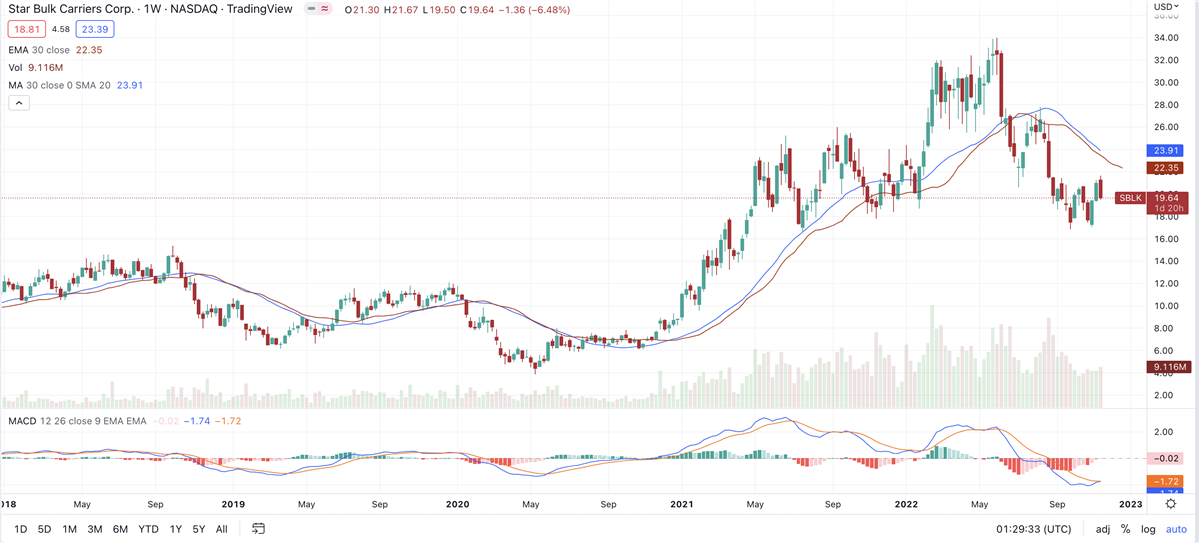 Could global shippers, such as Star Bulk Carriers (NASDAQ: SBLK), be making a comeback?
Could global shippers, such as Star Bulk Carriers (NASDAQ: SBLK), be making a comeback? In 2021, and then again as recently as six months ago, these stocks were market leaders, with names including Matson (NYSE: MATX), ZIM Integrated Shipping Services (NYSE: ZIM) and Danaos (NYSE: DAC).
Dry bulk commodities are generally unprocessed raw materials intended for use in various manufacturing processes. Dry bulks comprise foods, such as grains, as well as industrial products such as metals. As you might imagine, these materials originate in certain parts of the world and are destined for processing in another far-flung location.
Star Bulk Carriers, based in Greece, provides sea transportation services in the dry bulk sector, whose vessels transport commodities that are termed “major bulks.” These include coal, iron ore, grains, fertilizers and steel products. Star Bulk has its own fleet of vessels, unlike other shippers who lease the vessels.
Star Bulk is up 26.33% year-to-date, despite more recent downturns. The stock is up fractionally since reporting earnings on August 4.
The company earned $2 per share, up 59% from the year-ago quarter. Revenue was $417.3 million, a gain of 34%.
Deceleration, But Strength Remains
While those numbers are certainly impressive, they actually represent a deceleration from the boom times of 2021, when pandemic-era orders, from all manner of consumer and business sectors, kept shippers busier than ever. However, shippers expect strong business ahead.
In the company’s earnings conference call, CEO Petros Pappas outlined some recent developments.
“During the first half of 2022, total dry bulk volumes were down by approximately 0.5%, mainly due to a 6% decrease of Chinese imports as a result of a candid zero COVID policy, export disruptions and the war in Ukraine,” he said.
However, he noted that growth is expected to recover during the rest of the year. He cited an expected expansion in the iron ore trade, following a slowdown in China’s steel industry due to “significantly higher input costs and a weak real estate market.”
Analysts have a “moderate buy” rating on the stock, according to MarketBeat analyst data. The price target is $33, representing a 32.05% upside.
The company generated more interest than normal last week because on Thursday, it announced a quarterly dividend of $1.65 per share. The stock goes ex-dividend on Wednesday, so it will likely open $1.65 lower than it would normally open that session. That decline is to accommodate the shareholder payout.
The dividend is payable to shareholders who owned the stock prior to Wednesday. The dividend will be paid on September 8.
Small Cap Price Leader
While Star Bulk is in the spotlight because of the upcoming dividend, the price leader within its industry is actually Torm (NASDAQ: TRMD), a U.K.based shipper of refined oil. Torm is a small cap that went public in 2018.
The stock gapped up 10% Thursday following its quarterly earnings report.
Does it make sense to chase a small company like Torm after a big price move? Well, the very unsatisfactory answer is, “It depends.” If you have strict trading rules, such as moving average support or a percentage gain or decline, then perhaps you can successfully manage the trade. But for a company like this, as opposed to a well-established, well-known large cap (from any industry), it’s imperative to understand what you want from the trade, and not just go in hoping for the best.
When it comes to fundamental strength, mid-cap Matson has shown double-digit revenue growth in each of the past eight quarters. During that time, earnings grew at high double-digit or triple-digit rates.
Expediting Delivery Of Goods
In its second-quarter report, Matson CEO Matt Cox pointed out some recent industry-wide developments. In addition to seaborne container shipping, other business units include logistics, truck and rail transportation, warehousing and supply-chain management.
“Rail congestion, particularly on the U.S. West Coast continues to be an issue for our transportation brokerage customers, and as a result, some of our customers are shifting modes from rail to truck to expedite the delivery of goods,” Cox said. “Our warehousing unit remains busy with inbound goods and transload volume exceeding outbound volume.”
Significantly, Cox added that “port congestion on the U.S. West Coast has improved and anchor time waits are considerably less than at the beginning of the year, but container dwell times at the terminals remain elevated, partly due to ongoing rail congestion I just mentioned.”
He noted that “rates have likely peaked for now. At this time, we expect an orderly marketplace for the remainder of the year with our vessels continuing to operate at or near capacity and earning a significant rate premium to the market and well above pre-pandemic rate levels.”
Matson shares are down 6.15% in the past week, but up fractionally in the past month.